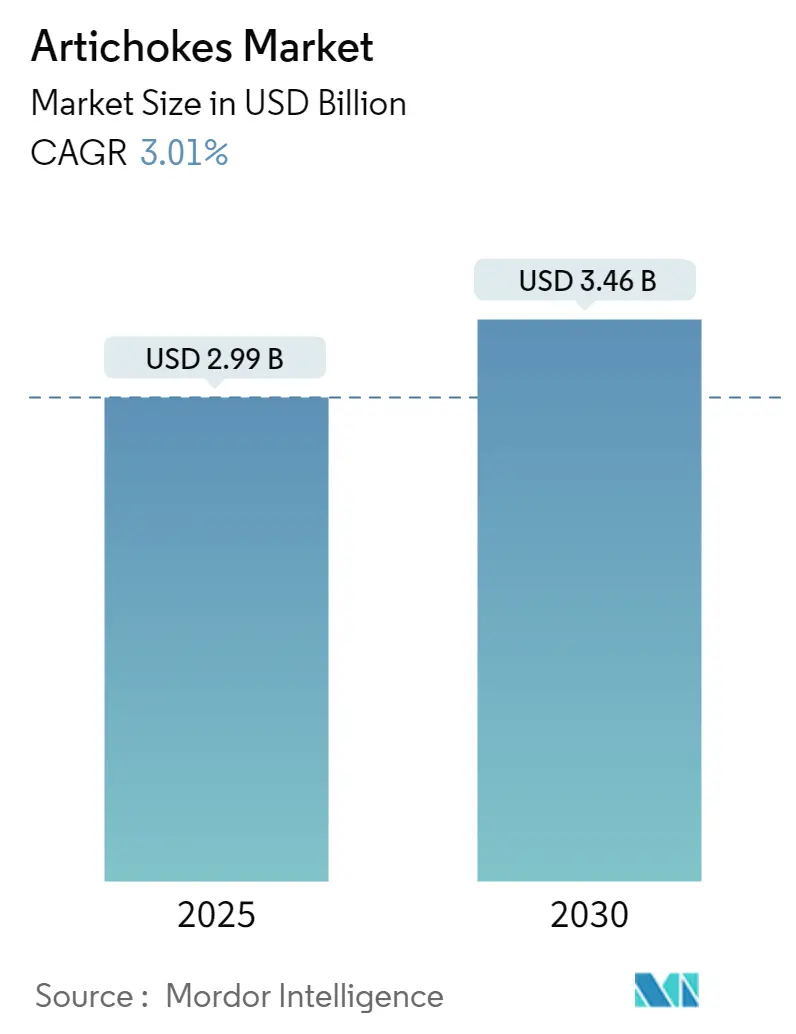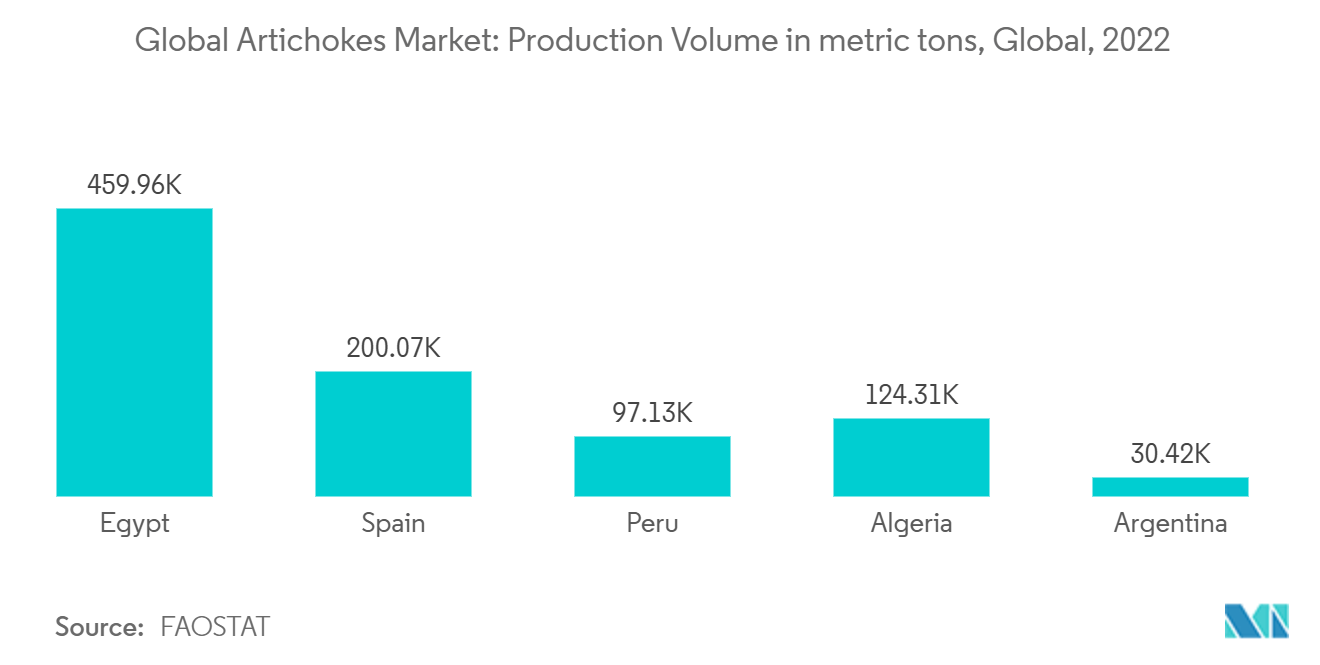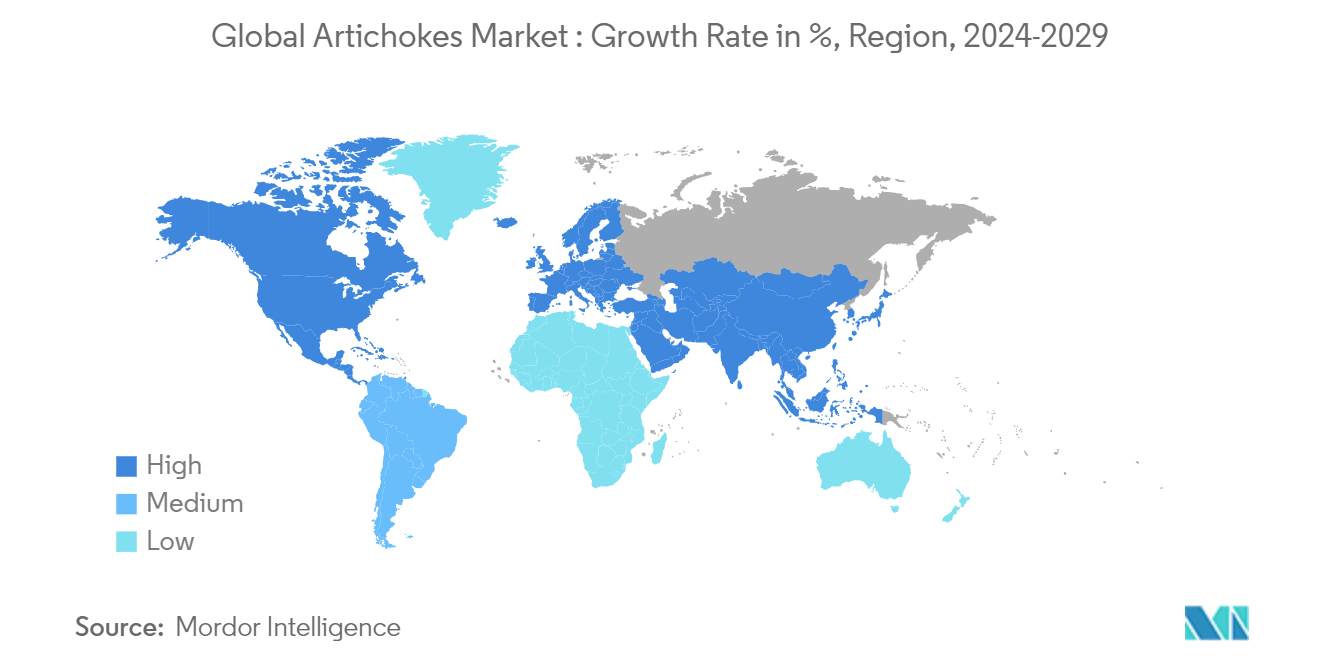Artichokes Market Analysis
The Artichokes Market size is estimated at USD 2.99 billion in 2025, and is expected to reach USD 3.46 billion by 2030, at a CAGR of 3.01% during the forecast period (2025-2030).
- Artichokes, known for their richness in fiber, vitamins, and antioxidants, have become essential for health-conscious consumers. Their benefits, including liver support, digestive aid, and cholesterol reduction, have further amplified global demand. Moreover, artichokes' versatility is evident as they feature in a wide array of dishes, from appetizers and salads to pizzas and dips. Their deep-rooted popularity in Mediterranean cuisine, combined with a rising appreciation in emerging markets, highlights the escalating demand.
- Italy, Spain, and Egypt benefiting from favorable climates, led the world in artichoke production. California, in the United States, stands out as another significant producer. For instance, according to FAOSTAT, Italy artichoke production jumped from 367,080 metric tons in 2020 to 378,110 metric tons in 2022. Furthermore, as key producers such as Italy and Spain enhance their supply chains and prioritize exports, the global availability of artichokes has surged, catering to the increasing demand in regions like North America and Europe.
- The rising consumer inclination towards organic and sustainably cultivated food is bolstering the artichoke market. A significant number of consumers are ready to pay a premium for organic artichokes, which not only champions a transition to eco-friendly farming methods but also fuels the market's growth. Additionally, this willingness to invest more in organic and sustainably sourced artichokes opens up a profitable avenue for producers catering to this demand. Such premium pricing not only benefits farmers but also incentivizes them to embrace sustainable practices, further amplifying the demand for organically grown artichokes.
Artichokes Market Trends
Steady Growth in the Artichokes Production
Over the period 2020-2022, global artichoke production increased by 10.0%. For instance, in 2020, the global artichokes production was 1,440,087.26 metric tons in 2020, and it increased to 1,584,513.73 metric tons by 2022. Countries such as Italy, Egypt, Spain, Peru, Algeria, and Argentina accounted for 81.41% of the global production in 2022. The production in the aforementioned countries was 378,110.00 metric tons, 459,962.08 metric tons, 200,070.00 metric tons, 97,131.00 metric tons, 124,305.30 metric tons, and 30,417.09 metric tons respectively. Countries in the Mediterranean, particularly Italy, Spain, and Egypt, dominate global artichoke production. These countries benefit from favorable climatic conditions that support large-scale cultivation. Italy is the world’s largest producer, followed by Spain and Egypt.
The use of modern agricultural techniques, including mechanized harvesting, drip irrigation, and improved pest control, has led to increased yields in key producing regions. Additionally, better seed varieties and cultivation methods have helped optimize production even in less ideal growing conditions. In some regions, controlled environment agriculture, such as greenhouse farming, has contributed to the year-round production of artichokes, reducing the impact of seasonality and expanding supply during off-peak seasons.
Europe Dominates the Global Artichokes Imports
Across Europe, the Mediterranean diet, with its emphasis on fresh vegetables such as artichokes, enjoys immense popularity. Southern European nations, especially Italy, Spain, and France, are at the forefront of this trend. As a result, there's a robust demand for both fresh and processed artichokes. With a rising emphasis on healthy eating, European consumers are turning to artichokes, lauded for their high fiber content, antioxidant properties, and benefits to digestion and heart health. Consequently, this has spurred an increased appetite for artichokes across various European nations, leading to expanded imports.
In Europe, France, Belgium, Germany, and Switzerland are dominating the artichoke imports. For instance, according to ITC Trade map, in 2023, the aforementioned countries imported artichokes worth USD 23,015 thousand, USD 6,330 thousand, USD 5,136 thousand, and USD 4,346 thousand respectively. In 2023, together these countries accounted for 53.1% of the global imports. France stands out as a leading importer of artichokes in Europe, where these vegetables play a pivotal role in both traditional and contemporary dishes. Meanwhile, Germany, despite not being a primary producer, is witnessing a surge in interest, driven by health-conscious consumers and the rising popularity of Mediterranean cuisine. Spain, Italy, the UK, and Egypt are the major importing destinations for France.
Global Artichokes Market News
- March 2024: Researchers at the University of Florida are working to improve artichoke preservation through advanced breeding techniques. By analyzing RNA sequences of various artichoke cultivars, they aim to pinpoint genetic markers linked to desirable traits, including an extended shelf life, resistance to physiological disorders, and a reduction in postharvest deterioration.
- October 2021: Enzymedica, a company specializing in digestive enzymes, introduced a new nutraceutical formula. This formula combines artichoke leaf extract, apple cider vinegar, and ginger root CO2 extract, targeting issues related to digestive transport and stomach emptying.
- September 2021: Waphyto, a Japanese botanicals firm, unveiled three body oils, each infused with artichoke leaf extracts. Designed for the winter season, the oils are named Enhance Body Oil, Balance Body Oil, and Unwind Body Oil.
Artichokes Industry Segmentation
Artichokes, scientifically recognized as Cynara cardunculus var. scolymus, belong to the thistle family and are cultivated primarily for their edible flower buds. These buds feature tough, pointed outer leaves (bracts) encasing a tender heart and a fuzzy, inedible core known as the choke, especially in mature buds. Predominantly featured in Mediterranean cuisine, artichokes are cherished for their nutty flavor and subtle sweetness. The Artichokes market report is segmented by Geography ( North America, Europe, Asia-Pacific, South America, and Middle East & Africa). The information includes Production Analysis (Volume), Consumption Analysis (Value and Volume), Export Analysis (Value and Volume), Import Analysis (Value and Volume), Price Trend Analysis, and Value Chain Analysis. The report offers the market size and forecasts in terms of volume (Metric tons) and value (USD) for all the above segments.
| Geography | North America | United States | Production Analysis | |
| Consumption Analysis and Market Value | ||||
| Import Market Analysis (Volume and Value) | ||||
| Export Market Analysis (Volume and Value) | ||||
| Price Trend Analysis | ||||
| Canada | Production Analysis | |||
| Consumption Analysis and Market Value | ||||
| Import Market Analysis (Volume and Value) | ||||
| Export Market Analysis (Volume and Value) | ||||
| Price Trend Analysis | ||||
| Europe | France | Production Analysis | ||
| Consumption Analysis and Market Value | ||||
| Import Market Analysis (Volume and Value) | ||||
| Export Market Analysis (Volume and Value) | ||||
| Price Trend Analysis | ||||
| Italy | Production Analysis | |||
| Consumption Analysis and Market Value | ||||
| Import Market Analysis (Volume and Value) | ||||
| Export Market Analysis (Volume and Value) | ||||
| Price Trend Analysis | ||||
| Belgium | Production Analysis | |||
| Consumption Analysis and Market Value | ||||
| Import Market Analysis (Volume and Value) | ||||
| Export Market Analysis (Volume and Value) | ||||
| Price Trend Analysis | ||||
| Spain | Production Analysis | |||
| Consumption Analysis and Market Value | ||||
| Import Market Analysis (Volume and Value) | ||||
| Export Market Analysis (Volume and Value) | ||||
| Price Trend Analysis | ||||
| Asia-Pacific | China | Production Analysis | ||
| Consumption Analysis and Market Value | ||||
| Import Market Analysis (Volume and Value) | ||||
| Export Market Analysis (Volume and Value) | ||||
| Price Trend Analysis | ||||
| Australia | Production Analysis | |||
| Consumption Analysis and Market Value | ||||
| Import Market Analysis (Volume and Value) | ||||
| Export Market Analysis (Volume and Value) | ||||
| Price Trend Analysis | ||||
| India | Production Analysis | |||
| Consumption Analysis and Market Value | ||||
| Import Market Analysis (Volume and Value) | ||||
| Export Market Analysis (Volume and Value) | ||||
| Price Trend Analysis | ||||
| South America | Peru | Production Analysis | ||
| Consumption Analysis and Market Value | ||||
| Import Market Analysis (Volume and Value) | ||||
| Export Market Analysis (Volume and Value) | ||||
| Price Trend Analysis | ||||
| Argentina | Production Analysis | |||
| Consumption Analysis and Market Value | ||||
| Import Market Analysis (Volume and Value) | ||||
| Export Market Analysis (Volume and Value) | ||||
| Price Trend Analysis | ||||
| Middle East And Africa | United Arab Emirates | Production Analysis | ||
| Consumption Analysis and Market Value | ||||
| Import Market Analysis (Volume and Value) | ||||
| Export Market Analysis (Volume and Value) | ||||
| Price Trend Analysis | ||||
| Saudi Arabia | Production Analysis | |||
| Consumption Analysis and Market Value | ||||
| Import Market Analysis (Volume and Value) | ||||
| Export Market Analysis (Volume and Value) | ||||
| Price Trend Analysis | ||||
| Turkey | Production Analysis | |||
| Consumption Analysis and Market Value | ||||
| Import Market Analysis (Volume and Value) | ||||
| Export Market Analysis (Volume and Value) | ||||
| Price Trend Analysis | ||||
| Algeria | Production Analysis | |||
| Consumption Analysis and Market Value | ||||
| Import Market Analysis (Volume and Value) | ||||
| Export Market Analysis (Volume and Value) | ||||
| Price Trend Analysis | ||||
| Egypt | Production Analysis | |||
| Consumption Analysis and Market Value | ||||
| Import Market Analysis (Volume and Value) | ||||
| Export Market Analysis (Volume and Value) | ||||
| Price Trend Analysis | ||||
Artichokes Market Research FAQs
How big is the Artichokes Market?
The Artichokes Market size is expected to reach USD 2.99 billion in 2025 and grow at a CAGR of 3.01% to reach USD 3.46 billion by 2030.
What is the current Artichokes Market size?
In 2025, the Artichokes Market size is expected to reach USD 2.99 billion.
Which is the fastest growing region in Artichokes Market?
Asia Pacific is estimated to grow at the highest CAGR over the forecast period (2025-2030).
Which region has the biggest share in Artichokes Market?
In 2025, the Asia Pacific accounts for the largest market share in Artichokes Market.
What years does this Artichokes Market cover, and what was the market size in 2024?
In 2024, the Artichokes Market size was estimated at USD 2.90 billion. The report covers the Artichokes Market historical market size for years: 2019, 2020, 2021, 2022, 2023 and 2024. The report also forecasts the Artichokes Market size for years: 2025, 2026, 2027, 2028, 2029 and 2030.
Our Best Selling Reports
Artichokes Industry Report
Statistics for the 2025 Artichokes market share, size and revenue growth rate, created by Mordor Intelligence™ Industry Reports. Artichokes analysis includes a market forecast outlook for 2025 to 2030 and historical overview. Get a sample of this industry analysis as a free report PDF download.





